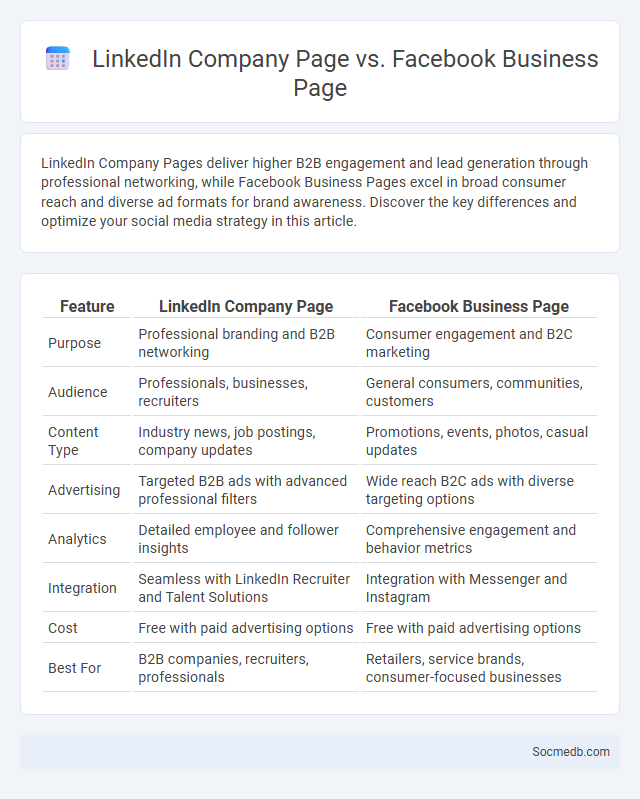
Photo illustration: LinkedIn Company Page vs Facebook Business Page
LinkedIn Company Pages deliver higher B2B engagement and lead generation through professional networking, while Facebook Business Pages excel in broad consumer reach and diverse ad formats for brand awareness. Discover the key differences and optimize your social media strategy in this article.
Table of Comparison
| Feature | LinkedIn Company Page | Facebook Business Page |
|---|---|---|
| Purpose | Professional branding and B2B networking | Consumer engagement and B2C marketing |
| Audience | Professionals, businesses, recruiters | General consumers, communities, customers |
| Content Type | Industry news, job postings, company updates | Promotions, events, photos, casual updates |
| Advertising | Targeted B2B ads with advanced professional filters | Wide reach B2C ads with diverse targeting options |
| Analytics | Detailed employee and follower insights | Comprehensive engagement and behavior metrics |
| Integration | Seamless with LinkedIn Recruiter and Talent Solutions | Integration with Messenger and Instagram |
| Cost | Free with paid advertising options | Free with paid advertising options |
| Best For | B2B companies, recruiters, professionals | Retailers, service brands, consumer-focused businesses |
Introduction to LinkedIn and Facebook Company Pages
LinkedIn and Facebook Company Pages are powerful platforms for building your brand and engaging with your audience. LinkedIn Pages focus on professional networking, company updates, and industry insights, making them ideal for B2B marketing and talent acquisition. Facebook Company Pages offer versatile tools for customer interaction, advertising, and community building, catering to both B2C and B2B audiences.
Purpose and Audience: LinkedIn vs Facebook
LinkedIn serves as a professional networking platform designed to connect industry experts, recruiters, and businesses, making it ideal for You to showcase your skills, build career opportunities, and share industry insights. Facebook targets a broader, more personal audience, focusing on social interactions, casual communication, and community engagement with friends and family. Choosing between LinkedIn and Facebook depends on whether Your purpose is professional growth or social connection.
Key Features of LinkedIn Company Pages
LinkedIn Company Pages offer robust tools for businesses to showcase their brand, share updates, and engage with a professional audience. Key features include rich content posting capabilities, detailed analytics for monitoring engagement, and the ability to highlight products and services effectively. You can leverage LinkedIn's networking potential to build industry authority and attract talent through advanced job posting and recruitment insights.
Core Functions of Facebook Business Pages
Facebook Business Pages offer essential tools designed to enhance Your brand's online presence, including customizable profile and cover photos, call-to-action buttons, and detailed insights on audience engagement. These pages facilitate direct communication with customers through messaging and reviews, enabling real-time interaction and feedback collection. Integration with Facebook Ads Manager provides robust advertising options that target specific demographics to maximize marketing effectiveness and drive business growth.
Page Creation and Setup: Step-by-Step Comparison
Creating and setting up a social media page involves selecting the right platform, defining a clear brand identity, and optimizing the profile with relevant keywords and visuals. Facebook, Instagram, and LinkedIn each offer unique features such as customizable templates, audience targeting options, and analytics tools that streamline the page creation process. Step-by-step execution includes account registration, profile customization, content planning, and integration of business information to enhance visibility and engagement.
Content Strategy: What Works Best on Each Platform
Effective content strategy tailors posts to the unique algorithms and audience preferences of platforms like Instagram, Facebook, Twitter, LinkedIn, and TikTok. Visual storytelling and short videos thrive on Instagram and TikTok, while LinkedIn favors professional content and thought leadership articles. You can maximize engagement by aligning your content format with each platform's strengths and user behavior.
Engagement and Analytics Tools Comparison
Social media engagement and analytics tools provide critical insights into audience behavior, content performance, and interaction metrics, helping refine your marketing strategy for maximum impact. Platforms like Hootsuite, Sprout Social, and Buffer offer comprehensive engagement tracking, while Google Analytics and Brandwatch excel in detailed sentiment analysis and trend forecasting. Choosing the right tools depends on your specific goals, budget, and the depth of data required to optimize your social media presence effectively.
Advertising and Promotion Capabilities
Social media platforms offer advanced advertising and promotion capabilities, enabling precise targeting based on demographics, interests, and behaviors to maximize your campaign's reach and engagement. Tools like Facebook Ads Manager and Instagram Promotions provide detailed analytics and customizable ad formats, allowing you to optimize performance and ROI effectively. Leveraging these features enhances brand visibility and drives conversions by connecting your message with the most relevant audience segments.
Industry Suitability: Which Page Fits Your Business?
Selecting the right social media platform depends on your industry's target audience and content style, with Instagram excelling for visually-driven sectors like fashion and food, while LinkedIn suits B2B and professional services best. Facebook offers broad reach ideal for retail and community engagement, whereas Twitter is preferred for real-time updates and tech or news-related businesses. Understanding each platform's user demographics and interaction patterns ensures your brand message resonates effectively with potential customers.
Conclusion: Choosing the Right Company Page for Your Goals
Selecting the right social media company page aligns directly with your marketing objectives and target audience, ensuring maximum engagement and brand visibility. Analyzing metrics such as follower demographics, content interaction, and platform-specific features helps determine the best fit for your business goals. Your strategic choice enhances customer connection and drives measurable growth across digital channels.
 socmedb.com
socmedb.com